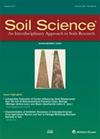利用239+240Pu放射性沉降核素评估潮湿的热带非洲森林和农田的土壤再分配
4区 农林科学
Q2 Agricultural and Biological Sciences
引用次数: 14
摘要
摘要由于热带非洲人口的迅速增长,预计未来几十年粮食需求将大幅增加,这将对土壤资源造成更大的压力。然而,对热带非洲土地转化为耕地后土壤再分配动态的了解有限,部分原因是长期景观尺度监测的基础设施限制。在这项研究中,使用放射性沉降物239+240Pu来评估位于刚果民主共和国、乌干达和卢旺达的两个农田和三个附近原始森林遗址沿地形梯度的土壤再分布。在研究区域,发现a239+240Pu的基线库存高于热带地区的典型预期(平均森林库存41 Bq m−2)。在239+240Pu的基础上,原始森林没有土壤沿地形梯度再分布的迹象。与此相反,在过去55年中,农田的土壤侵蚀和沉积分别达到37 cm (81 Mg ha−1 yr−1)和40 cm (87 Mg ha−1 yr−1)。农田场地表现出较高的坡内变异性,直接靠近沉积场地的地点显示出严重的土壤侵蚀。这项研究显示了一种评估热带土壤再分配的有价值方法的适用性,并提供了对世界上最社会经济和生态脆弱地区之一土壤退化率和模式的见解。本文章由计算机程序翻译,如有差异,请以英文原文为准。
Assessing soil redistribution of forest and cropland sites in wet tropical Africa using 239+240Pu fallout radionuclides
Abstract. Due to the rapidly growing population in tropical Africa, a substantial rise
in food demand is predicted in upcoming decades, which will result in higher
pressure on soil resources. However, there is limited knowledge on soil
redistribution dynamics following land conversion into arable land in
tropical Africa that is partly caused by infrastructure limitations for
long-term landscape-scale monitoring. In this study, fallout radionuclides 239+240Pu are used to assess soil redistribution along topographic
gradients at two cropland sites and at three nearby pristine forest sites
located in the DR Congo, Uganda and Rwanda. In the study area, a
239+240Pu baseline inventory is found that is higher than typically
expected for tropical regions (mean forest inventory 41 Bq m−2).
Pristine forests show no indication of soil redistribution based on 239+240Pu along topographical gradients. In contrast, soil erosion and
sedimentation on cropland reached up to 37 cm (81 Mg ha−1 yr−1)
and 40 cm (87 Mg ha−1 yr−1) within the last 55 years,
respectively. Cropland sites show high intra-slope variability with
locations showing severe soil erosion located in direct proximity to
sedimentation sites. This study shows the applicability of a valuable method
to assess tropical soil redistribution and provides insight into soil
degradation rates and patterns in one of the most socio-economically and
ecologically vulnerable regions of the world.
求助全文
通过发布文献求助,成功后即可免费获取论文全文。
去求助
来源期刊

Soil Science
农林科学-土壤科学
CiteScore
2.70
自引率
0.00%
发文量
0
审稿时长
4.4 months
期刊介绍:
Cessation.Soil Science satisfies the professional needs of all scientists and laboratory personnel involved in soil and plant research by publishing primary research reports and critical reviews of basic and applied soil science, especially as it relates to soil and plant studies and general environmental soil science.
Each month, Soil Science presents authoritative research articles from an impressive array of discipline: soil chemistry and biochemistry, physics, fertility and nutrition, soil genesis and morphology, soil microbiology and mineralogy. Of immediate relevance to soil scientists-both industrial and academic-this unique publication also has long-range value for agronomists and environmental scientists.
 求助内容:
求助内容: 应助结果提醒方式:
应助结果提醒方式:


